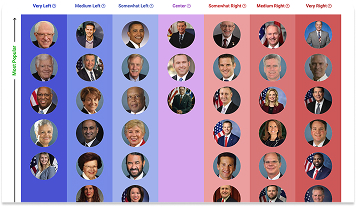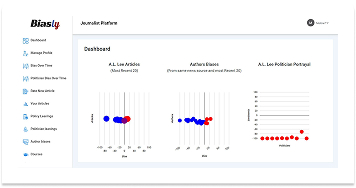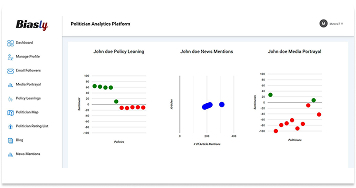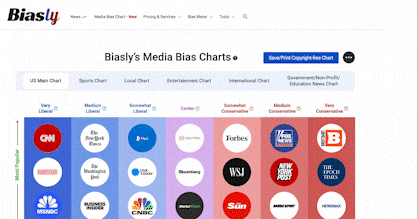Bias Meter
Extremely
Liberal
Very
Liberal
Somewhat Liberal
Center
Somewhat Conservative
Very
Conservative
Extremely
Conservative
-100%
Liberal
100%
Conservative

Biasly determines media bias ratings through a dual-layered approach combining artificial intelligence and analyst review. The platform’s proprietary bias detection engine, Bias Meter, evaluates sentiment, policy position alignment, and language framing across thousands of data points in news articles. Analysts then verify and interpret the AI’s findings, providing additional context where needed. Learn more
- Profile
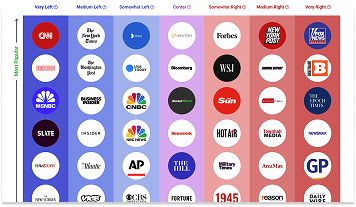
New York Post on the media bias chart
New York Post has a Bias Score of 46% Medium Right which is based on a variety of factors including its policy and politician leanings, article ratings, and the use of biased language. Its Reliability is rated as Good, and additional analytical insights are available in the other tabs.
- Bias Rating
46% Medium Right
- ReliabilityPolicy Leanings
14% Somewhat Right
Extremely
LiberalVery
LiberalModerately
LiberalSomewhat Liberal
Center
Somewhat Conservative
Moderately
ConservativeVery
ConservativeExtremely
Conservative-100%
Liberal100%
Conservative
Average Reliability
*Our bias meter rating uses data science including sentiment analysis, machine learning and our proprietary algorithm for determining biases in news articles. Bias scores are on a scale of -100% to 100% with higher negative scores being more liberal and higher positive scores being more conservative and 0% being neutral. The rating is an independent analysis and is not affiliated nor sponsored by the news source or any other organization.
Politician Portrayal71% negative
Continue For Free
Create your free account to see the in-depth bias analytics and more.
By creating an account, you agree to our Terms and Privacy Policy, and subscribe to email updates.
Policy Leanings Analysis
Policy | Bias score |
|---|
New York Post Editorial Patterns
New York Post’s coverage of political topics often reflects a Medium Right bias, with consistent patterns in phrasing, source selection, and thematic focus that are Moderate Right. This content analysis examines how New York Post handles liberal and conservative issues and evaluates its language choices and editorial tendencies.
Coverage of Liberal vs. Conservative Topics
New York Post’s articles include topics such as climate change, the war in Ukraine, and immigration. For example, anti-DEI measures in the military are portrayed as “toughening”, “anti-woke”, and promoting “merit”. These articles demonstrate a right-leaning bias through word choice and a favorable framing of conservative perspectives.
Articles covering liberal policies and politicians are portrayed differently. For example, Democrats who opposed a Republican spending bill were described as “failures” with “untenable” policy positions. Rather than conveying these perspectives neutrally, New York Post attempts to portray these issues in a negative light.
News bias can manifest in subtle ways, through word choice, issue-framing, and source diversity. Recognizing how these small factors produce larger effects on bias is essential to analyzing news bias.
Policy and Issue Framing
When covering the war in Gaza, New York Post often favors conservative perspectives instead of a neutral portrayal of the issue. For example, articles on the war in Gaza often only include Israeli or Republican perspectives, rather than other ideological perspectives.
On the other hand, liberal perspectives are often criticized and portrayed negatively. For example, a teacher critical of the dismemberment of the Department of Education was labeled as an “anti-Semite” and “disgusting”. Instead of presenting multiple perspectives neutrally, this article portrays liberal perspectives as ostracizing or polarizing.
Coverage of issues is heavily shaped by how these issues are framed and what perspectives are included. Be sure to look out for when positive diction is used and who this diction is correlated with. This tends to show some type of bias the author may have.
Coverage and Relevance
New York Post’s reporting often touches on key issues like government spending, LGBTQ+ rights, and education, which are central to the media bias discussion. As such, it serves as a compelling case study for examining source bias and news media bias in state-focused reporting.
Readers who wish to further explore how New York Post compares with other publications can visit Biasly’s Media Bias Chart to analyze tone and word choice in real time.
New York Post Bias Analysis
New York Post was founded in 1801 by Alexander Hamilton, a founding father of the United States. New York Post claims to:
“shine a bright light on the people and institutions that shape our readers’ lives; we break big stories and set the news agenda; and we offer engaging, fun, and addictive content to the country and the world.”
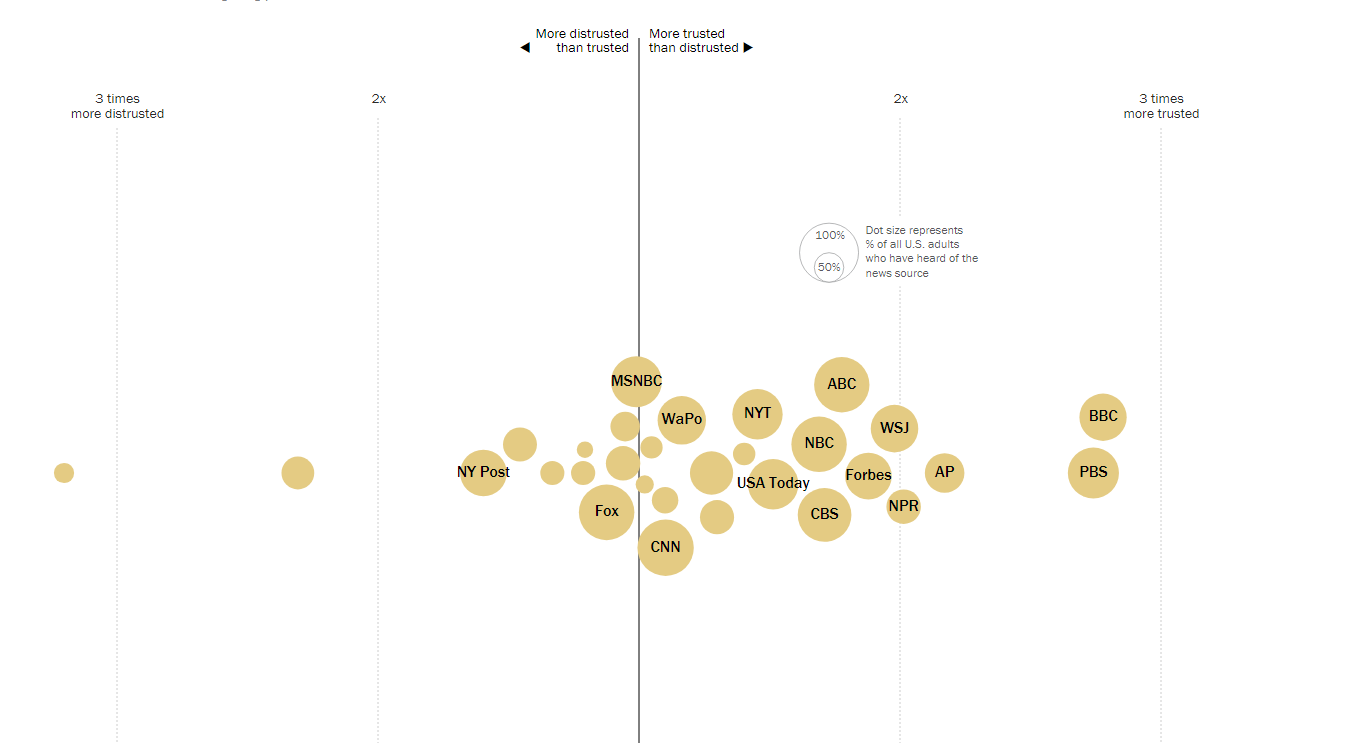
Source: Pew Research Center
According to their LinkedIn, New York Post reaches 90 million viewers per month, making it a major influence in political reporting and public perception. This article delves into New York Post’s editorial tendencies to explore whether political bias is present.
Is New York Post Biased?
Based on Biasly’s evaluations, New York Post is rated as Medium Right.
By examining content patterns and the broader context of media influence, we aim to offer a balanced perspective on New York Post’s political bias, and contribute to the ongoing discussion about bias in the news.
How Does Biasly Rate News Sources?
Biasly uses proprietary algorithms and a team of analysts to provide comprehensive bias evaluations across thousands of news outlets. Over 200,000 articles from more than 3,200 sources have been analyzed to identify the most accurate and unbiased stories.
Biasly assigns each outlet three key scores:
- Reliability Score – Reflects factual accuracy
- AI Bias Score – Generated via natural language processing
- Analyst Bias Score – Assessed by human political analysts
These scores are based on seven core metrics: Tone, Tendency, Diction, Author Check, Selection/Omission, Expediency Bias, and Accuracy. These elements help analysts and algorithms evaluate the political attitude conveyed by each article.
Biasly’s Bias Meter ranges from -100% (most left) to +100% (most right), with 0% indicating neutrality. The system evaluates individual articles based on political terms, policies, figures, and sentiment to calculate precise bias ratings.
Is New York Post Politically Biased?
New York Post earns a Medium Right rating for its AI Bias Score and a Somewhat Right for its Analyst Bias Score. The Analyst Bias Score is generated by reviewers from liberal, moderate, and conservative backgrounds. Analysts reviewed multiple New York Post articles and noted a preference for criticizing liberal politicians and perspectives. For example, here is a quote from the article “Hochul refuses to pony up state funds to keep Statue of Liberty open during government shutdown”:
“Gov. Kathy Hochul is refusing to come to the rescue and provide state funding to keep the Statue of Liberty open if it closes due to the partial government shutdown that commenced Wednesday.”
Hochul, a Democrat, is portrayed negatively, even though the shutdown was unrelated to her actions.
This Bias score is determined through natural language processing that evaluates the tone, word choice, and opinion embedded in the reporting. Recent AI evaluations highlight right-leaning narratives in articles discussing the Republican Party and other issues.
Analysis of Bias in New York Post Online Articles
To evaluate this, we can analyze select New York Post articles through several of Biasly’s bias rating criteria: Tone, Tendency, Author, Diction, and Expediency Bias.
- Tone: The overall attitude conveyed by the article
- Diction: Specific word choices made by the writer
- Author: The background and social presence of the journalist
- Tendency: Patterns of bias in the writer’s broader body of work
- Expediency Bias: Quick visual or textual indicators like headlines and photos that imply bias
An example of an article that shows bias through tone is “Syracuse professors gloat over Charlie Kirk’s ‘ironic’ death, bizarrely thank witches for his demise: ‘Can rest in piss’’’. While the comments that the article is reporting on are provocative, this does not excuse a non-neutral portrayal of the issue. Here is a quote from the article:
“Two ghoulish left-wing Syracuse University professors celebrated the assassination of conservative activist Charlie Kirk last week, mocking the ostensibly “ironic” nature of his demise and crediting witches for delivering his death.”
The article uses words like “ghoulish” and “lefty” to describe the professors. Furthermore, this description is not presented neutrally. Rather, the article highlights these aspects to correlate left-leaning perspectives with anti-right rhetoric. By pointing these factors out, the article insinuates that it is because of their left-leaning perspectives that they wrote these provocative comments, rather than for some other reason. Nonetheless, the diction of this article is not neutral and favors a right-leaning bias.
An example of how tone can convey bias is seen in the article “Trump admin threatens to withhold $67M in funding for magnet school programs in NYC, Chicago and Northern Virginia over discrimination concerns”. While this article does not contain inflammatory diction, the tone of the article portrays a right-leaning bias through its criticism of left-leaning school policies. Here is a quote from the article:
“The consequences of the NYC DOE’s policy are predictable: students are subject to hostile educational environments or denied equal access to benefits of education programs or activities or will be in the future.”
Rather than portraying multiple perspectives on issues like gender rights and racial justice in schools, New York Post only aims to criticize these policies.
Looking at the background of an author can also provide support when analyzing whether an article may be biased. For example, when looking at Diana Nerozzi’s twitter, it is clear she may have a right-leaning bias:
I attempted to ask Fauci several times on what he personally did to demand answers into the origins of COVID-19.
I always come with honest answers that Americans want to know.
That’s why the White House refuses to call on me, and then calls ME “disrespectful.” https://t.co/B3zWrYaEEF
— Diana Nerozzi (@diana_nerozzi) November 22, 2022
Her posts only focus on criticizing liberal politicians and policies, while uplifting conservative ones. While this does not prove Nerozzi’s articles are biased, it provides a context for analysis.
Another way to see how bias may be present in an article is to look at the author’s previous articles and see if there is a tendency for bias. For example, here are the headlines for some of Josh Christenson’s previous articles:
- “Founder of pro-gun LGBTQ group probed in Charlie Kirk shooting is radical trans leftist who advocated violence”
- “Kristi Noem tears into predecessor Alejandro Mayorkas on ‘Pod Force One’ for opening southern border: ‘Don’t know how he slept at night”
- “Senate GOP bill would form public transit violence task force after Iryna Zarutska’s murder on Charlotte train”.
Christenson’s articles tend to criticize liberal perspectives and portray conservative ones positively. While this does not explicitly mean an article of Christenson’s may be biased, it still may help with bias analysis.

Source: New York Post
An example of expediency bias can be seen in the article “Some teachers caught vilely mocking Charlie Kirk’s assassination still in the classroom— as House Republican calls for probe”. The image above is the cover photo for this article. The cover photo on its own is provocative, by contrasting the image of celebration with Charlie Kirk’s vigil. The headline is provocative, using “vilely” instead of more neutral wording. Based on these factors, it is likely that the article has a right-leaning bias.
Analysis of New York Post Opinion Articles
When analyzing bias, it is important to distinguish between factual reporting and opinion articles. Factual reporting is meant to be an unbiased and neutral portrayal of an event. On the other hand, opinion articles are more explicitly biased, as they are meant to come from an author’s perspective. It is therefore also important to see how bias presents itself in New York Post’s opinion articles.
An opinion article that can be seen as biased is “Late-night TV is truly dead — and you can only blame egotistical, politically obsessed Kimmel and Colbert themselves”. The headline is provocative, using phrases like “egotistical, politically obsessed” to describe the subjects of the article. This is an example of expediency bias and signifies a right-leaning bias.
Another opinion article that has a right-leaning bias is “Wikipedia’s censorship is a threat to civilization itself”. Here are some of the quotes from the article:
“The news publication I founded and run, the Federalist, has been viciously censored by Wikipedia’s cabal of anonymous editors for more than a decade.”
Notice words like “viciously” are inflammatory and not neutral.
“We originally drew Wikipedia’s ire back in 2014 when we exposed left-wing darling Neil deGrasse Tyson as a serial fabulist and fabricator.”
Once again, words like “serial fabulist and fabricator” are inflammatory and do not attempt to frame the issue neutrally.
“The rise of Wikipedia’s censorship sadly reflects the rise of leftist repression and authoritarianism in the United States and throughout the world.”
The language in this article is strongly critical of left-leaning ideologies, depicting a clear right-leaning stance.
Who Owns New York Post?

Source: Wikipedia
New York Post is owned by News Corporation, a news conglomerate that is headed by Rupert Murdoch. Murdoch is known for owning other conservative news outlets such as Fox News and The Sunday Times. While this does not necessarily make New York Post right-leaning, it is important to keep in mind. It is likely that this conservative influence has an effect on editorial decisions.
Who Funds New York Post?
New York Post operates as a for-profit publication and is primarily funded through advertising revenue, digital traffic monetization, and sponsored content. As one of the largest tabloid-style outlets in the U.S., it generates substantial income from high-volume readership, online ads, and social media engagement. The outlet also offers paid subscriptions for its digital edition and select premium content, though advertising remains its main financial driver.
Because the New York Post’s business model depends heavily on audience scale and advertiser appeal, its coverage often emphasizes attention-grabbing headlines, sensational stories, and political commentary that resonates with its core readership. This incentive structure may encourage editorial choices that amplify controversy or align with the ideological preferences of its most engaged audience segments.
Additionally, as part of a larger corporate network that includes other politically influential outlets, the Post may face indirect pressure to maintain themes and narratives that are commercially successful within that ecosystem. While this does not mean the publication is obligated to promote a specific agenda, the financial realities of tabloid journalism and advertising-driven revenue can shape story selection, tone, and framing.
Overall, while New York Post maintains editorial independence, its reliance on advertising and audience-driven revenue can contribute to coverage that reflects the interests and expectations of its readership and parent network.
How to Evaluate Bias
Although Biasly rates New York Post as Medium Right, it’s important to remember that bias can vary from article to article. New York Post also covers a conservative-leaning state with objectivity on many issues, from state legislation to social developments. This complexity underscores the importance of examining each article individually. So, let’s learn how to evaluate media bias.
Recognizing media bias requires awareness and critical thinking. Often, readers trust news sources that affirm their existing beliefs—a psychological tendency known as confirmation bias. This makes it harder to identify slanted narratives or one-sided reporting.
To combat this, it’s essential to challenge your assumptions by consulting multiple viewpoints and verifying news through third-party analysis. Tools like Biasly’s media bias ratings allow readers to compare the same news story across the political spectrum.
Ultimately, bias isn’t always a matter of what is said—it’s also about what is left out, how topics are framed, and which stories are chosen for coverage. Learning to recognize these patterns can help readers make more informed decisions and develop greater media literacy.
To start comparing news outlets and gain a better understanding of bias, sign up for Biasly’s Media Bias & News Analytics Platform to see how stories vary between sources.
New York Post Reliability Analysis
Is New York Post Reliable?
Biasly gives New York Post a Good score in terms of their reliability. This is due to their usage of multiple quotes and sources. This fact, however, does not mean that New York Post’s bias does not matter. Even if news outlets are reliable, their articles can still be biased through the manipulation of language and issue-framing.
Further investigation is needed to determine whether bias or other factors are affecting its accuracy. At Biasly, we specialize in evaluating not just bias but also the reliability of media outlets. Let’s explore the accuracy and trustworthiness of New York Post.
How to Evaluate Reliability?
Reliability refers to how trustworthy or accurate a news source is. If we can’t trust what we read, then continuing to consume content from that outlet serves little purpose. So how do we evaluate a news outlet’s reliability?
There are several potential measures of reliability to look out for when trying to determine whether a media source is reliable or not. Red flags for an unreliable article can include the presence of wild, unsubstantiated claims, facts dependent on other unreliable sources, heavy use of opinionated language, and more. In contrast, hallmarks of a reliable source include:
- Absence of subjective language
- Citing credible sources (e.g., .gov, .edu, academic references)
- Verifiable facts and statistics from multiple outlets
- Use of primary sources, like interviews or transcripts
- Consistency with coverage across other platforms
Biasly’s reliability scores incorporate these elements in evaluating media outlets.
So How Does New York Post Fare in Its Reliability?
The political reliability index developed by Biasly assesses both accuracy and trustworthiness. New York Post currently holds Good Reliability Score, which is calculated as a weighted average of:
- Fact Analysis Score – Evaluates the accuracy of claims, facts, and evidence.
- Source Analysis Score – Assesses the number, diversity, and credibility of sources and quotes used.
New York Post’s Source Analysis Score is Average at 45% Reliable. This suggests moderate trustworthiness in its sourcing practices. The score is AI-generated and considers quote length, frequency, diversity, and quality.
The Fact Analysis Score of New York Post is Excellent at 90% Reliable. This further shows how well New York Post supports its claims, addresses selection and omission bias, and presents verifiable evidence.
While New York Post leans toward factual reporting, occasional lapses, such as unbalanced viewpoints or incomplete data can affect its reliability rating. These nuances emphasize the importance of analyzing individual articles.
New York Post’s Accuracy and Reliability
According to Biasly’s analysis, New York Post maintains Good Reliability Score, but individual articles may vary significantly. Let’s dive into the details.
Two common types of bias that affect factuality include:
- Selection Bias – Highlighting or omitting stories to fit a particular narrative.
- Omission Bias – Leaving out differing perspectives or relevant details to skew perception.
Biasly’s accuracy ratings use a scale from 1% (least accurate) to 100% (most accurate). Factors include the presence of supporting evidence, internal and external reliable sources, and balanced viewpoints.
Analysis of Reliability in New York Post’s Online News Articles
New York Post aims to serve its readers with objective, fact-based reporting. However, readers should distinguish between news reporting and opinion pieces to evaluate credibility effectively.
Quality of Sources and Facts Used
New York Post often uses credible sources, but some articles skew in how comprehensively they present opposing viewpoints. For example, in the article “ICE receives more than 150K job applications as Trump’s crackdown on illegal immigration continues”, there is a limited number of sources from different viewpoints. Here are the sources that were cited in the article
- New York Post, American news outlet
- Kristi Noem, United States Secretary of Homeland Security
New York Post and Kristi Noem are both considered to be conservative-leaning. There are six quotes, with three of them being long. Here are some of the quotes from this article:
“ICE has received more than 150,000 applications from patriotic Americans who want to defend the homeland by removing the worst of the worst criminal illegal aliens from the U.S.” – Kristi Noem
By positing ICE applicants as “patriotic” while assuming all immigrants are the “worst” and “criminals”, Noem clearly has a conservative slant to her rhetoric.
“Americans are answering their country’s call to serve and help remove murderers, pedophiles, rapists, terrorists, and gang members from our country.” – Kristi Noem
The inclusion of only conservative quotes with positive narrative towards them suggests that this article has a right-leaning bias. The limited number of sources cited and the lack of sources from different viewpoints hurt the reliability of this article. For an article to be reliable, it can’t just have a lot of quotes. It also needs its sources to represent different ideological viewpoints to ensure that a reader understands both sides of an issue.
An article that may be considered reliable is “4 House Republicans vote with Dems to block resolution censuring Ilhan Omar for Charlie Kirk comments”. Here are some of the sources cited:
- New York Post, an American news outlet
- Tom McClintock, Republican House Representative
- Nancy Mace, Republican House Representative
- Ilhan Omar, Democratic House Representative
- Delia Ramirez, Democratic House Representative
This article has eleven quotes, with ten of them being long. Here are some of the quotes from the article:
Tom McClintock: “Censure is formal punishment by the House and we have already gone too far down this road. Omar’s comments were not made in the House and even if they were, they broke no House rules. A free society depends on tolerating ALL speech — even hateful speech — confident that the best way to sort good from evil is to put the two side by side and trust the people to know the difference.”
Ilhan Omar: “While I disagreed with Charlie Kirk vehemently about his rhetoric, my heart breaks for his wife and children. I don’t wish violence on anyone. My faith teaches me the power of peace, empathy, and compassion. Right-wing accounts trying to spin a false story when I condemned his murder multiple times is fitting for their agenda to villainize the left to hide from the fact that Donald Trump gins up hate on a daily basis.”
By including quotes from different ideological perspectives, the reader gains a more nuanced understanding of this issue. This is because rather than attempting to frame the issue with a specific ideological slant, the article includes multiple quotes from different ideological perspectives to see the opposition to different arguments. New York Post, Tom McClintock, and Nancy Mace are all considered to be right-leaning. Ilhan Omar and Delia Ramirez are considered to be left-leaning. Compared to the last article, there is a much more diverse range of sources cited.
Additionally, the article draws opinions from members who voted for and against Ilhan Omar’s censure mechanism. This means the article attempted to portray the perspectives of both sides in this way. Furthermore, the article does not try to portray one set of views as correct. Rather, the quotes are framed neutrally to allow the reader to come to their own conclusion.
Selection and Omission Bias
An example of selection bias can be seen in the article “Trump, Starmer sign $350B tech deal to spur AI, nuclear energy and quantum computing”. Here are some of the quotes highlighted by the article:
“This trip has galvanized $350 billion in deals across many sectors, and we’re committed to ensuring that the UK is a secure and reliable supply of the best AI, hardware and software on Earth, and we supply that and make sure we supply it in quantity to the UK”. – Trump
Trump is a conservative figure and portrays the deal in a positive light.
“It just has the ability to make our lives better and easier… You’ll have computers doing work that right now is being done by humans”. – James Burnham (former General Counsel for DOGE)
James Burnham, because he formerly worked with DOGE, can be considered right-leaning. Burnham also portrays the deal positively. Therefore, the article only highlights conservative perspectives to portray the deal in a positive light. By only portraying the conservatives who praise this deal, readers are not able to understand any opposing views to the deal. In this sense, the article has a right-leaning bias.
An example of omission bias can be seen in the article “Trump asks Supreme Court to let him fire Fed governor Lisa Cook”. The article solely focuses on why Trump believes the Fed governor needs to be fired and only highlights Trump’s lawyers’ arguments as to why this is allowed. Here are some of the quotes highlighted by the article:
“This application involves yet another case of improper judicial interference with the President’s removal authority…The government is likely to succeed on the merits because Cook lacks a Fifth Amendment property interest in her continued service as a Governor of the Federal Reserve.” – Solicitor General John Sauer
John Sauer is a right-leaning figure and the article only references quotes from his perspective. By omitting the liberal perspectives as well as the opposing lawyers’ arguments, the article frames this issue in a one-sided way. Trump’s arguments are seen as merely common sense through this portrayal. Therefore, this article has a right-leaning bias.
An article that does not have selection or omission bias is “House Republicans advance Trump-backed stopgap government funding bill”. This article provides multiple perspectives: Democrat and Republican, as well as those for and against the funding bill. Here are some of the quotes cited in the article:
“Congressional Republicans, including [Senate Majority] Leader John Thune and [House] Speaker Mike Johnson, are working on a short-term ‘CLEAN’ extension of Government Funding to stop Cryin’ Chuck Schumer from shutting down the Government.” – Trump“
Trump is a conservative figure who is portraying the Democrats as the issue with the funding bill.
“The House Republicans-only spending bill fails to meet the needs of the American people and does nothing to stop the looming healthcare crisis.” – House Minority Leader Hakeem Jeffries and Senate Minority Leader Chuck Schumer
On the other hand, both Jeffries and Schumer are Democrats who are portraying conservatives as the issue to the funding bill. By providing both sides of the argument, the reader can formulate a more informed conclusion.
So, Is New York Post Reliable?
Overall, New York Post can be considered to be an outlet that is very reliable. It demonstrates a consistent goal of journalistic integrity and often supports claims with sources and quotes, even if they might be more right-leaning. Occasional omissions and framing bias do appear, particularly on culturally sensitive or partisan issues.
As media literacy improves, readers can more easily detect issues with selection bias, omission bias, and factuality. To strengthen your ability to assess reliability across the political spectrum, use the News Bias Checker to compare how multiple outlets report the same story.
This empowers you to consume more accurate, balanced, and dependable news.
Additional Insights
News Source Comparison
New York Post is often compared to other right-leaning news outlets like The Daily Mail and The Daily Telegraph. To get a more balanced perspective, it is useful to look at stories from the opposite side of the media bias spectrum. Some complementary news outlets for New York Post are Vice and Business Insider.
Readers seeking balanced political coverage may compare New York Post’s framing of issues with outlets rated as Center or Lean Left on our Media Bias Chart, or explore other regional papers on our Similar Sources page.
Notable Contributors and Authors
New York Post has both staff writers and freelance reporters. However, most of their reporters share a common right-leaning bias. Even with these biases, their staff maintains a good level of editorial integrity. Reporters such as John Christenson, Ryan King, and Kaydi Pelletier often reflect this right-leaning bias.
Related Tools and Resource Pages
To better understand how New York Post fits into the broader media landscape, we recommend exploring these helpful resources:
- Media Bias Chart: See where New York Post ranks among hundreds of media outlets across the political spectrum.
- Political Bias Chart: Visualize political slants of news sources across various policy areas.
- Journalist Bias Analytics Platform: Explore how individual journalists contribute to bias within their publications.
- Politician Bias Analytics Platform: Compare how politicians are framed differently by New York Post and other outlets.
- Media Literacy Education Platform: Learn how to critically assess media sources, bias techniques, and news reliability.
Frequently Asked Questions
New York Post is rated as Medium Right based on Biasly’s media bias algorithm, which assesses sentiment, article framing, and policy favorability.
New York Post has been cited for spreading misinformation. For example, they have been called out for editing and cropping a video of Joe Biden to make him seem confused. They have also been cited for fabricating a story in which homeless veterans were kicked out of a hotel to make space for migrants.
Biasly uses a combination of AI sentiment analysis and human analyst review to assess tone, fact accuracy, source quality, and media bias indicators. Learn more on our Bias Meter page.
Yes, but with caution. New York Post typically upholds fact-based journalism, though occasional partisan framing and selective reporting may impact overall news reliability.
Ratings are based on recent news using data science and A.I. technology.
Military Spending
| Date | Sentiment | Associated Article | Snippet |
|---|---|---|---|
| 08/25/2019 | 75% For | Trump Family Detentions Flores Agreement (link) | So, of course, the Trump administration is doing the opposite in a baldfaced |


























